The Monastics of Angkor Wat
Cambodia is the Kingdom of the Khmers, they who built Angkor, a city of stone temples and edifices so vast. Reputedly covering more than 1,000 square miles, Angkor is 20 times larger than the next biggest preindustrial city of Tikal in Mayan Guatemala. The most famous Angkor monument is the palatial complex known as the Angkor Wat. It is BIG. The outer walls encloses more than 82 hectares of land.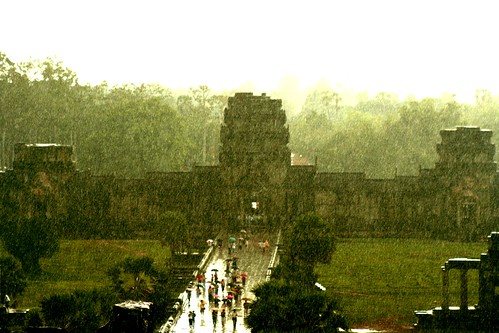
phototip: Rain can be your friend. It can provide a mysterious ambience, especially if the streaks are captured by fast shutter speed.
f/5.6, 0.004s, 155mm, ISO 100, -1/3EV, cropped
The west gate of Angkor Wat, as taken from the topmost level of the central temple,Siem Reap, Cambodia
What struck me most was the humanistic strand that helped keep Angkor Wat alive today: the religious. In all its 850 years of existence, the temple has never been abandoned, really. Ascribing its discovery to a Portuguese monk or a French explorer is a Westernized view, romanticized but distorted. While the temple fell into neglect after the 16th century, the temple has never really been empty. It has always enjoyed a throng, if not an encampment of Buddhist monks and nuns.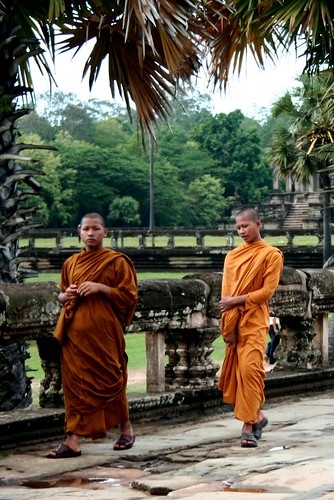
phototip: ….
f/5.6, 0.008s, 55mm, ISO 200, -1/3EV, cropped
Monks at Angkor Wat, Siem Reap, Cambodia
Without argument, monks and nuns are mendicants. They live from the benevolence of patrons. Begging for their daily needs, they do not work for their very sustenance in our accepted conventional sense. Idealized their roles may be, there is some dissent against their dependence on alms in Cambodia and probably in other Buddhist societies as well. The question begs: how could they remain “idle” amidst the growing poverty of the very society they mean to serve?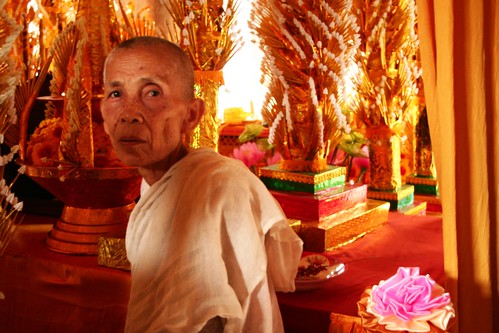
phototip: Most portraits become more effective if you get the subject look at you. In my case, the nun was tidying up the altar. I composed the shot while her back was away from me. I knew that soon she would turn. She did.
f/4.5 , 0.067s, 33mm, ISO 800, -1/3EV
A shrine at the uppermost central shrine of the Angkor Wat, Siem Reap, Cambodia
History provides the answer. Monks and nun are merely following norms developed along the centuries. Societies in civilizations as old as the Khmers were divided into classes. Each class had a role to fulfill. Without divisions that were almost so rigid to prevent someone from moving between classes, there would have been chaos. In a practical sense, artistic achievements, like that of the majesty of Angkor, would not have been reached as well.
phototip: Tight shots makes the message clearer.
f/5.6. 0.02s, 55mm, ISO 800, -1/3EV, cropped
A monk offering supplications at the central sanctuary tower of Angkor Wat, Siem Reap, Cambodia
Art cannot prosper in a vacuum. Only societies that have a great level of surfeit of food and riches would have the extravagance to commit sections of their populations to doggedly sole-minded pursuits like music, dance, painting and architecture. The Khmers did. How else could the grand designs materialize if the artists were not sheltered and allowed to do what they did without fear of hunger and want? By the same rationale, there rose a section of the society given the time and space to enlighten and spiritually “sustain” life- the monastics.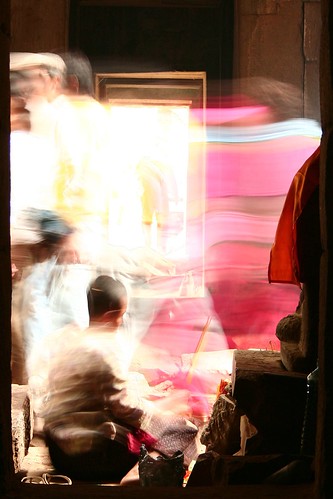
phototip: Watch out for stillness against speed. I set up a tripod at a doorway, waited for the nun to freeze in a prayer, while tourists passed by. The exposure of 1.6 seconds created the colored blur.
f/5.6 , 1.6s, 55mm, ISO 100, +1/3EV, cropped
at the central uppermost temple of the Angkor Wat, Siem Reap, Cambodia
Today, Buddhist monks and nuns in Cambodia continue the tradition of alm-seeking and live only if the public sticks to the convention of support. I found out that there are rules governing this sustenance. For starters, the monks can only seek what are existential: food, clothing, shelter and medicine. All else are considered trivial. 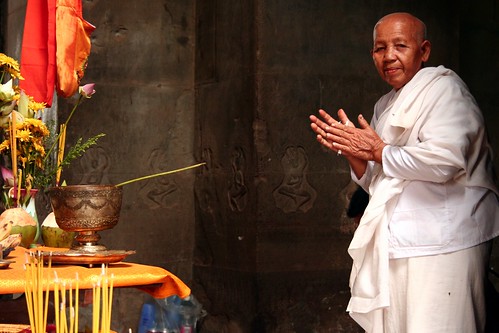
phototip: White stands bold even if the subject is in a dark corner, especially when contrasted against the colored ornaments.
f/5.6, 0.01s, 49mm, ISO 400, uncropped
A nun at the Angkor Wat, Siem Reap, Cambodia
By leading a life of an ascetic, monks and nuns are examples to the masses of what can be renounced in life. By freely choosing to lead simply, they remind the people that enlightenment can only be achieved by giving up material things. That is how Buddhism’s concept of nirvana can be attained. I too am reminded of the biblical line of “Blessed are the poor in spirit, for theirs is the kingdom of heaven” (Matthew 5:3).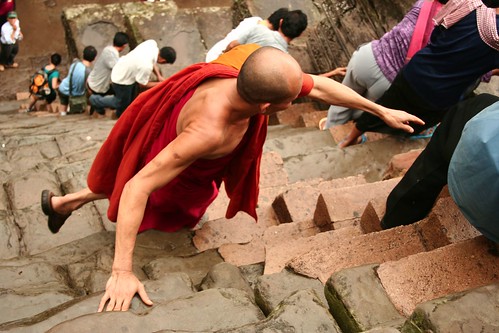
phototip: The Angkor Wat’s central temple is notorious for the steep staircase. Don’t take unnecessary risk in getting the shot you like. I took the photo at the landing before I descended the steep stairs, with the camera safely tucked inside a padded and secured bag.
f/5.6, 0.008s, 37mm, ISO 100, -1/3EV, uncropped
The difficult descent from the uppermost central shrine of the Angkor Wat, Siem Reap, Cambodia
The normal title of "nun" is conferred to female monastics who may be considered equal to male ascetics. These ladies often wear robes of white or gray, as opposed to the saffron sported by the monks. Monks and nuns are expected to be totally celibate and generally avoid physical contact with the opposite sex.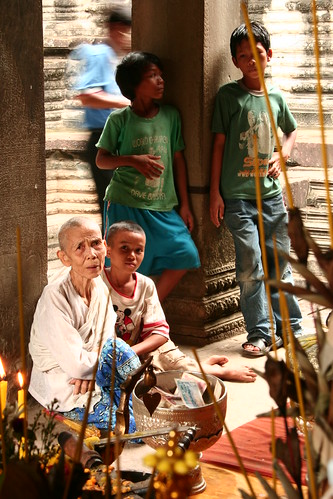
phototip: Watch out for expressions that convey strong emotions and tell a story.
f/16, 0.2s, 55mm, ISO 400, -1/3EV, uncropped
A Buddhist nun and at a shrine in the uppermost central temple of the Angkor Wat, Siem Reap, Cambodia
Meditation is associated with the monastics. Silence accompanies simplicity. Monks and nuns are considered to be in a different plane, having lived the “inner world”. People may chose to ignore them sometimes but ultimately, their presence fills in a need that no one else can.
phototip: Strong backlight creates bold shadows that can be an effective background for incense smoke.
f/5.6, 0.008s,55mm, ISO 800,-1/3EV, uncropped
Meditation scene in the uppermost central temple of the Angkor Wat, Siem Reap, Cambodia






1 comment:
Great photoblog Farl..very informative. Congrats..keep it up!
Post a Comment